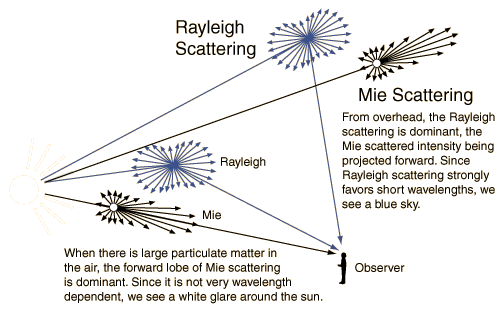If you, like the WeatherBlog, were out and about on the Alpine highways at dusk yesterday, you may have admired the borderline kitschy lighting: A low-hanging full moon against a soft pastel-colored sky, with glowing mountains next to it. In the face of such natural spectacles, you can pause for a moment, rejoice in the high-pressure weather with a slight westerly current and the pleasantly predictable firn conditions. Or you can think about the fact that air is actually transparent. So why is the sky usually blue, sometimes red and in this case purple-blue? As we know, the sun emits electromagnetic radiation in all possible wavelengths. We are interested in the visible part of the spectrum, i.e. wavelengths from around 400 (purple/blue) to 750 (red) nanometers.
When sunlight hits the molecules and other particles in the atmosphere, it is scattered by them. If the scattering particles are significantly smaller than the wavelength, this is known as Rayleigh scattering. The scattering is inversely proportional to the fourth power of the wavelength. This means that shorter (blue) wavelengths are scattered more strongly, both forwards and backwards in a kind of dipole pattern. This means that blue light is scattered around small molecules everywhere in the air, which is why the sum of the scattered light appears blue, at least when the sun is high in the sky. The moon has no atmosphere on which light could be scattered, so the sky there is always black and the sunsets are rather gothic in color. On Earth, on the other hand, the sky is wonderfully colorful at sunset. The sun is low above the horizon and the light has to travel a long way before it reaches the waiting observer. On this way, it passes all kinds of particles that scatter the blue components until there are none left. Only long, reddish wavelengths reach us, which then make mountains appear pink, for example. When we stand on a snow-covered mountain at midday, it is usually white. A few mountain ranges away, however, the mountains are somehow yellowish. Similar to the sun, the white mountains radiate across the entire visible spectrum. On the way to us, some blue light is lost and the incoming light therefore has a yellow tint. (This is why the sun is often depicted as a yellow ball with hair. The hair symbolizes the even radiation in all directions). If the mountains are even further away, at some point the blue scattered light from the atmosphere begins to overlay this effect and we have the promising blue mountains on the horizon. If light is scattered by large particles, for example water droplets, the whole thing works slightly differently and is called Mie scattering. This is largely independent of wavelength, meaning that all colors are scattered in the same way. The light is mainly scattered forwards here, not in all directions as with Rayleigh scattering. At midday, the sky in the direct vicinity of the sun appears whitish and becomes increasingly blue as the distance to the sun increases. If there are enough large particles in the atmosphere, we see Mie scattering as white light where we are directly hit by the sun's rays. Light that does not hit us directly can also be scattered in this way, but we do not see the effect as we are outside the direction of scattering.
The WeatherBlog wishes you lots of fun in the remaining snow (it will be foehn and warm at the weekend with a frontal layer that could give us 30° for the first time next week) and a beautiful, not too long summer with lots of kitschy sunrises and sunsets.






